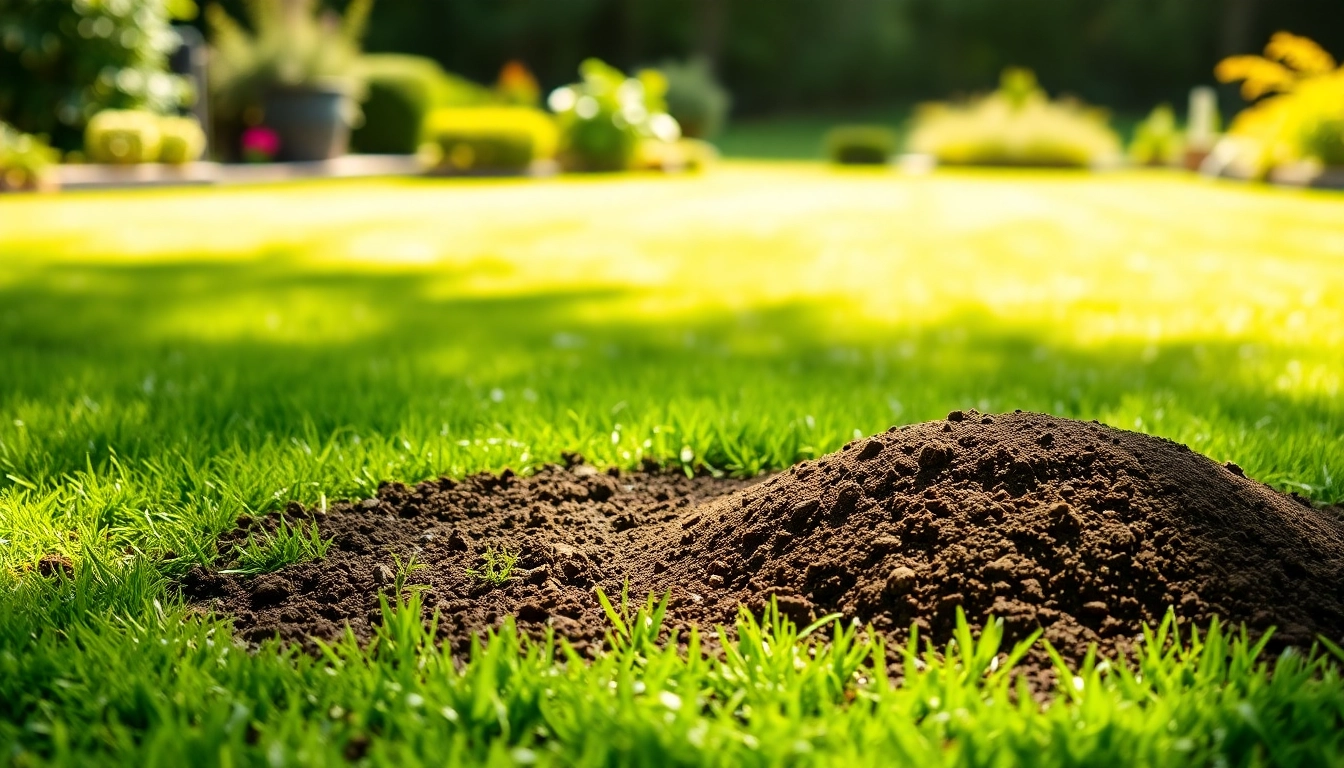Understanding Lawn Top Dressing
What is Lawn Top Dressing?
Lawn top dressing is the practice of applying a thin layer of material, usually organic compost, soil, or sand, over the grass surface. This process is essential in maintaining a healthy lawn, as it helps improve the soil quality without the need for extensive reworking. Essentially, it enriches the existing soil, allowing the grass to grow more robustly and healthily. The layer applied is typically between 1/8 and 1/4 inch deep, providing the necessary nutrients and promoting better drainage. For more detailed insights, you can explore lawn top dressing recommendations and best practices.
Benefits of Lawn Top Dressing
Top dressing provides a multitude of benefits for your lawn:
- Soil Aeration: It improves aeration, allowing the roots of the grass to receive more oxygen and grow stronger.
- Nutrient Enrichment: Compost and other organic materials contribute essential nutrients, fostering healthy growth.
- Moisture Retention: A top dressing layer can help retain moisture, reducing the frequency of watering.
- Weed Control: By applying a quality mix, you can suppress weed growth naturally.
- Improved Drainage: Enhances soil structure, allowing excess water to drain away effectively.
- Leveling Effect: Helps in smoothing out uneven areas, creating a more aesthetically pleasing lawn.
Common Materials Used for Lawn Top Dressing
The materials used in lawn top dressing can vary widely, but some of the most effective include:
- Compost: Rich in nutrients, compost is often the best choice for fertilizing your lawn.
- Sandy Soil: Improves drainage and is commonly mixed with compost for better moisture retention.
- Topsoil: A good base material that provides structure and nutrients.
- Peat Moss: Great for moisture retention, it can help sandy soils to hold onto water.
- Leaf Mold: A less common but effective option that improves moisture retention and soil structure.
When to Perform Lawn Top Dressing
Ideal Seasons for Lawn Top Dressing
The timing of your lawn top dressing is crucial for optimal results. The best seasons to perform top dressing are typically:
- Early Spring: This period stimulates growth for cool-season grasses.
- Fall: Ideal for warm-season grasses as they prepare for winter recovery.
It’s essential to avoid top dressing during extreme heat or cold, which can stress or damage the lawn.
Signs Your Lawn Needs Top Dressing
Before you start top dressing, you should look for specific indicators that your lawn needs attention:
- Uneven Surface: Visible dips and rises where the grass is uneven.
- Thin Grass: Areas with sparse grass that fail to fill in.
- Compact Soil: Soils that become too hard to penetrate would benefit from a top dressing application.
- Drainage Issues: Water pooling in certain areas can signal a need for improved soil quality.
Seasonal Top Dressing Tips
Different seasons require different approaches to lawn top dressing:
- In Spring: Apply before the peak growing season to promote lush growth.
- In Fall: Focus on repairing damage from the summer months and preparing for winter dormancy.
- In Winter: Avoid top dressing as grass growth is minimal, and soil is often too wet or frozen.
How to Top Dress Your Lawn
Step-by-Step Top Dressing Process
Top dressing your lawn can be achieved through a systematic approach:
- Prepare the Lawn: Mow the grass slightly shorter than usual to allow the topping material to contact the soil effectively.
- Clean the Area: Rake away debris, leaves, and any other materials that could inhibit the dressing.
- Mix the Top Dressing Material: Combine your compost, soil, and sand in a wheelbarrow or tarp before application.
- Apply the Mixture: Spread the mixture evenly over the lawn using a broadcast spreader or by hand.
- Work it In: Lightly rake the top dressing into the grass to avoid smothering it.
- Water the Lawn: Water the area lightly; this helps settle the new layer and starts the nutrient absorption process.
Tools and Equipment Needed for Top Dressing
Having the right tools can make the process more efficient:
- Spreader: A broadcast or drop spreader distributes materials evenly.
- Rake: A landscape rake helps spread and level the material.
- Wheelbarrow: For transporting top dressing material.
- Garden Hose: For watering post-application.
Common Mistakes to Avoid
To achieve the best results from top dressing, avoid these common pitfalls:
- Applying Too Much: Overdressing can smother grass and create drainage issues.
- Ignoring Soil Testing: Without understanding your soil’s existing health, you may apply incorrect materials.
- Poor Timing: Top dressing during extreme temperatures can stress the grass.
- Neglecting Water: Failing to water afterward can hinder the effectiveness of your efforts.
Choosing the Right Mix for Top Dressing
Effective Top Dressing Combinations
Choosing the right mix depends on your grass type and soil conditions:
- Heavy Clay Soils: A mix of topsoil, sand, and compost.
- Loamy Soils: Mostly compost or well-rotted manure with minimal sand.
- Sandy Soils: A mix that includes peat moss to improve moisture retention.
DIY Top Dressing Mix Recipes
Here are a few recipes you can make at home to use for top dressing:
- Recipe 1: 1 part compost, 2 parts topsoil, 1 part sand.
- Recipe 2: 2 parts compost, 1 part peat, and 1 part sand for better moisture retention.
- Recipe 3: 2 parts leaf mold, 1 part topsoil for a nutrient-rich mix.
Understanding Soil Types for Lawn Top Dressing
Understanding the type of soil you have can significantly influence your choice of top dressing:
- Clay Soil: Retains moisture but compacts easily. Use sand to enhance drainage.
- Sandy Soil: Drains quickly but retains fewer nutrients. Use organic materials to boost nutrient retention.
- Loamy Soil: The ideal mixture of clay, sand, and silt; these soils typically require minimal additional treatment.
Maintaining Your Lawn After Top Dressing
Post-Top Dressing Lawn Care
After top dressing, maintaining your lawn is crucial for its health:
- Regular Mowing: Keep the lawn at an appropriate height to encourage new growth.
- Avoid Heavy Traffic: Minimize foot traffic to prevent soil compaction.
- Observe Growth: Monitor how the grass responds to the top dressing; adjust care as necessary.
Fertilization After Top Dressing
Fertilization post-top dressing should be done cautiously:
- Use a balanced fertilizer to avoid shock to the lawn.
- Apply fertilizers about four weeks after top dressing to ensure the grass has time to recover from the application.
- Consider using organic fertilizers to complement the nutrients provided by the top dressing.
Watering Techniques for Optimal Results
Watering is essential for the success of top dressing:
- Initial Watering: Lightly water the lawn immediately after application.
- Consistent Moisture: Keep the top dressing damp, but avoid overwatering which can lead to runoff and nutrient loss.
- Timing: Water during the early morning or late afternoon to reduce evaporation losses.



